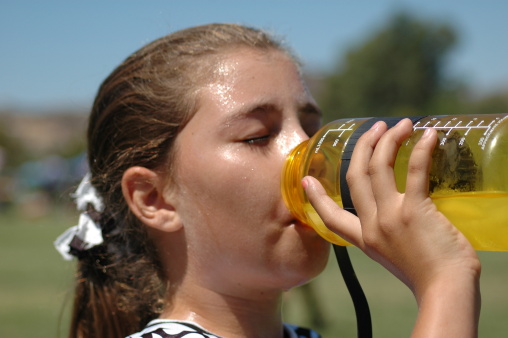Thermoregulation refers to the maintenance of a stable core body temperature. Thermoregulation is vital for every athlete as maintaining a safe body temperature avoids conditions such as hyperthermia and hypothermia. (For more information see environmental considerations – regulation of body temperature). A child’s body will overheat 3-5 times faster than an adult.
For children and young athletes, thermoregulation is not as well developed as it is for adults. Children and young athletes have underdeveloped sweat glands, which means they sweat less that adults and therefore, are more affected by their surrounding environments. In addition to this, children and young athletes have a small body mass to surface area ratio. This means that they have a large surface area (skin) compared to their body mass (weight). This means they are more vulnerable to their surrounding environment than adults. To better understand the body mass to surface area ratio, think about cooking potatoes. If you boil the whole potato it takes longer to cook compared to the potato that is cut into smaller pieces. This is because the smaller pieces have more surface area for the heat to come into the potato and a smaller mass to heat compared to the whole potato. The same thing applies to people. Children and young athletes have a larger surface area (skin) for the heat or cold to enter the body, but a smaller mass (weight) to be affected by this temperature. As such there are various considerations for thermoregulation when children and young athletes are doing physical activity.
Considerations of thermoregulation for the ways children and young people engage in sport
Poor thermoregulation means children and young athletes need to have their body temperature monitored closely in sports that are performed in the heat or in the cold. Considerations such as, appropriate clothing, time of day the sport is played, availability of shade, and access to fluid need to be addressed to ensure the safety of children and young athletes during the sport.
For example, a game of football (soccer) played on a hot day:
- Can be broken into quarters to improve access to fluids
- Can be played in the early morning to avoid the heat of the day, and
- Children should have sunscreen applied and wear clothing that allows for greater air flow
Or if children and young athletes are snowboarding:
- Children should wear warm clothing
- Have an adequate extended warm-up
How conditions associated with thermoregulation are managed
Thermoregulation issues such as hyperthermia, or hypothermia need to be managed swiftly and properly. Hyperthermia refers to any heat-induced condition such as heat exhaustion and heatstroke. The management of heat exhaustion is:
- lie the person in a cool place with circulating air
- remove unnecessary clothing
- sponge with cool water
- give cool water to drink
- seek medical aid
Heatstroke is an emergency situation and is managed by:
- DRSABCD
- lie the person in a cool place with circulating air
- remove unnecessary clothing
- apply cold packs or ice
- cover with a wet sheet
- ensure 000 has been called
- give water
Hypothermia is a cold-induced condition and is managed by:
- DRSABCD
- lie the person in a warm dry place
- avoid wind, rain, sleet, cold, and wet grounds
- remove wet clothing
- warm the athlete with a blanket, head cover and warm drinks
- ensure 000 has been called

